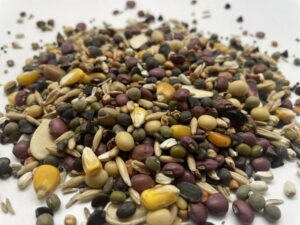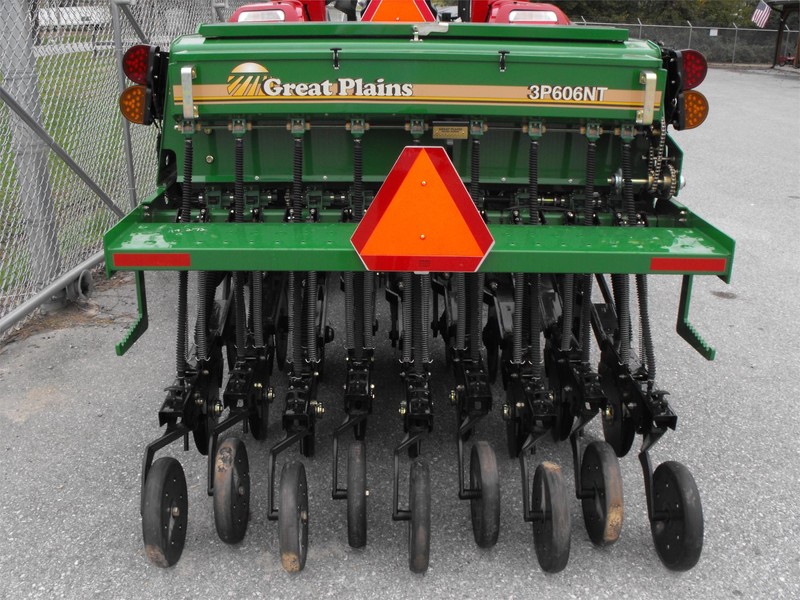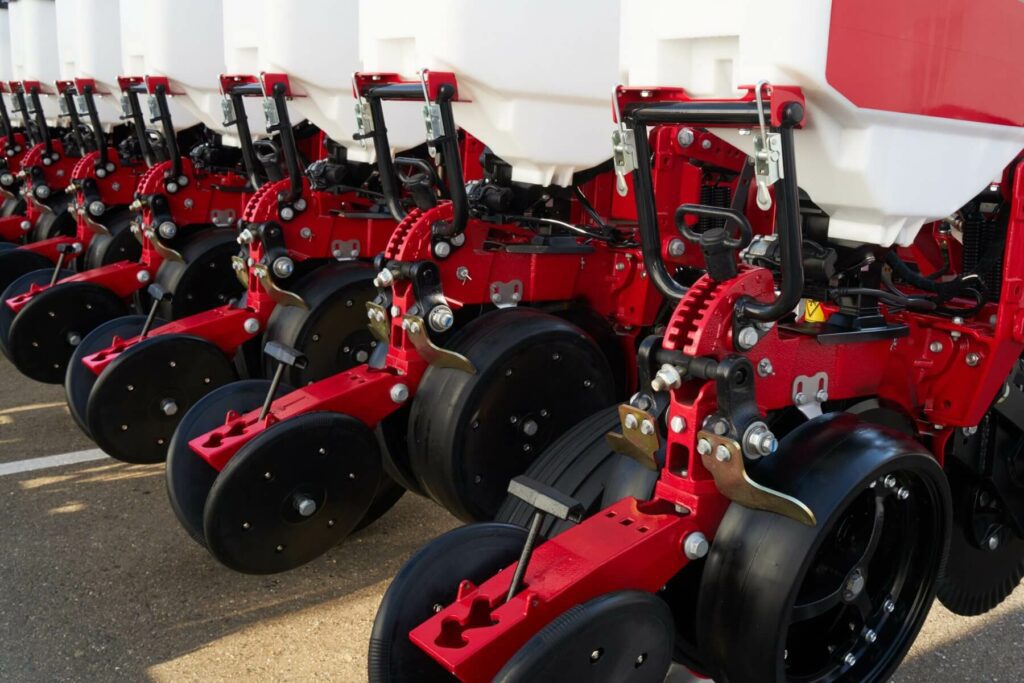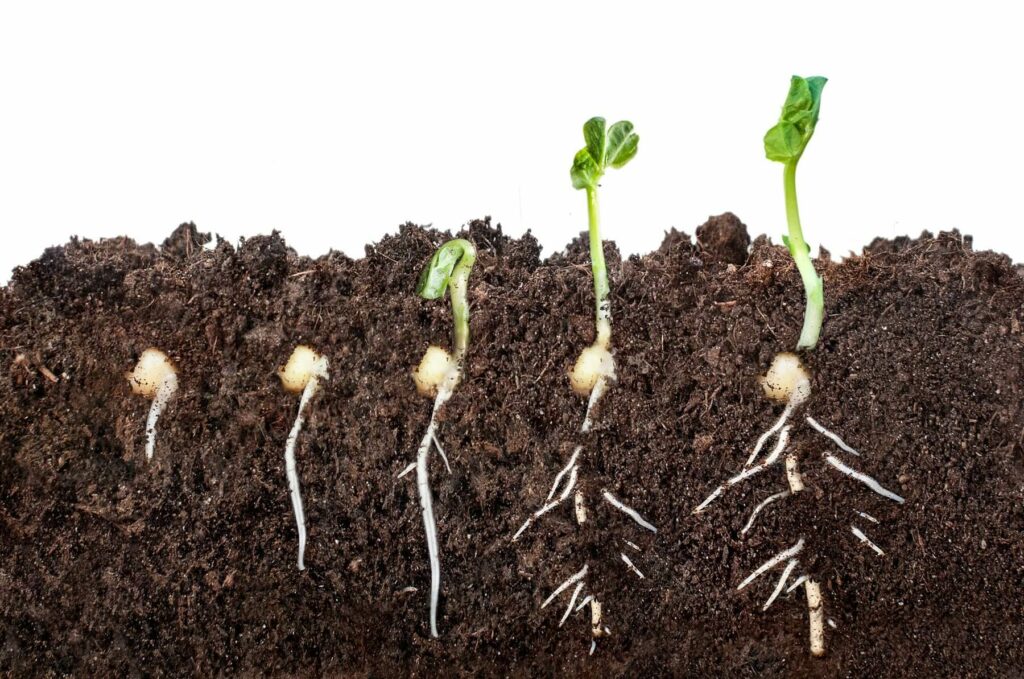
Seeds are pretty amazing. A tiny little seed is a living organism that contains an embryo and all of the resources needed to allow that plant to begin its life cycle. Just as with your cash crops, a successful planting process is critical for the success of a cover crop. Without proper establishment, the plants will never have the chance to do their job of healing and building the soil. There are a variety of ways to plant cover crops and the best method for your situation will likely depend on the context of your operation.
What Does A Seed Need?
Before unpacking the different methods of seeding cover crops, it is helpful to understand what a seed needs to germinate. Like all living things, seed needs water, energy, and protection.
- Water is needed to begin and sustain all forms of life. Moisture must be imbibed into the seed to initiate the germination process. Seeds will vary in the amount needed, with small seeds needing far less moisture than large seeds.
- Like all metabolic processes, seed germination requires energy. The seed endosperm and the cotyledons have stored energy in the form of carbohydrates, fats, and proteins that fuel germination when environmental conditions are favorable for growth. This stored energy is what makes seeds valuable as energy for humans as well! Stored energy in the seed is very limited, with small seeds having less than large seeds. Planting depth becomes critical for small seeds as the energy required to “push” up from depth will not be found in small seeds. Plants must be able to generate their own energy shortly after emergence through photosynthesis and through the absorption of soil nutrients, therefore it is difficult for seedlings to survive in a shaded environment or in extremely poor soils.
- It’s a jungle out there in your soil, therefore, seeds and seedlings must be protected from multiple things in order to survive and thrive. Bugs, rodents, birds, wind, water, heat, and cold can all be terminal for the seedling if not protected. Proper timing (based on soil temperature), proper seed placement and depth, proper seeding rates, and proper soil conditions will all give the seed the best chance for survival.
 Equipment Considerations
Equipment Considerations
The best way to achieve seeding success is to get the seed in the ground at the proper depth. This gives the best access to moisture for the imbibition process (especially for larger seeds) as well as providing the best access to soil nutrients and providing a protective environment. Both planters and drills will get the seed in the ground with good seed to soil contact and proper planting depth. No-till drills and planters are preferred because they can cut the residue, create a proper seed trench, place the seed, and cover the seed while leaving the majority of the residue in place to armor the soil against erosion.
 Typically, a drill or an air seeder with drill openers is used for seeding cover crops rather than a planter that would be used for corn. One reason for this is that drills have narrower row spacing (7.5” or 10” vs 30” typically) than planters which allow the cover crops to cover the soil and fill the root zone more quickly. Drills are also less expensive to purchase, operate and maintain, require a less experienced operator, and are able to meter a much more diverse mixture of seeds than most planters will.
Typically, a drill or an air seeder with drill openers is used for seeding cover crops rather than a planter that would be used for corn. One reason for this is that drills have narrower row spacing (7.5” or 10” vs 30” typically) than planters which allow the cover crops to cover the soil and fill the root zone more quickly. Drills are also less expensive to purchase, operate and maintain, require a less experienced operator, and are able to meter a much more diverse mixture of seeds than most planters will.
 If a drill is not available, planters can be used. The best planters for cover crops are narrow row planters (15” or 20”) that are used with a special designed planter plate for cover crop seed mixes that most equipment manufacturers now offer. While planters are more expensive to own and operate, they do have some advantages over drills. Planters will give a much more precise and consistent seeding depth as well as more accurate seed metering. Parallel linkage, better down pressure, seed firming attachments and better electronic monitoring of the planting process are also advantages of the typical planter over the typical drill.
If a drill is not available, planters can be used. The best planters for cover crops are narrow row planters (15” or 20”) that are used with a special designed planter plate for cover crop seed mixes that most equipment manufacturers now offer. While planters are more expensive to own and operate, they do have some advantages over drills. Planters will give a much more precise and consistent seeding depth as well as more accurate seed metering. Parallel linkage, better down pressure, seed firming attachments and better electronic monitoring of the planting process are also advantages of the typical planter over the typical drill.
 If you do not own a drill or planter, check with your local equipment dealer, your local conservation office or an organization like Pheasants Forever as they often will have drills available for rent. Customer operators in your area may also be available to do the seeding operation for you.
If you do not own a drill or planter, check with your local equipment dealer, your local conservation office or an organization like Pheasants Forever as they often will have drills available for rent. Customer operators in your area may also be available to do the seeding operation for you.
 If no planting equipment can be found or if labor to plant or drill is a limiting factor, broadcasting the seed is also an option. There are many types of broadcasting equipment from drones to airplanes to large row crop broadcasters to hand broadcasting equipment for small plots. This method will have reduced germination since it is more difficult for the seed to achieve seed to soil contact for proper water absorption. To maximize broadcasting success, follow these guidelines:
If no planting equipment can be found or if labor to plant or drill is a limiting factor, broadcasting the seed is also an option. There are many types of broadcasting equipment from drones to airplanes to large row crop broadcasters to hand broadcasting equipment for small plots. This method will have reduced germination since it is more difficult for the seed to achieve seed to soil contact for proper water absorption. To maximize broadcasting success, follow these guidelines:
- Select mostly smaller seeds (clovers, brassicas, millets, teff grass, etc) as they require less water for germination than do larger seeds. Small seeds can also more easily achieve seed to soil contact.
- Watch the weather forecast closely and try to broadcast seed right before a rain event or irrigate the field if that is an option The rain drop impacts will help the seed get into contact with the soil as well as provide the moisture required for germination. Timing ahead of a rain can be difficult, especially in more arid environments, and thus broadcasting is generally used in higher rainfall areas or in fields that can be irrigated.
- Increase the seeding rate by 50-100% over a drilled rate. Some of the exposed seed on the soil surface will get eaten by crickets, beetles and rodents and some seed will never reach the soil surface where it can germinate. It will become a numbers game so increasing the rate of seed will increase your chances of success.
- If you are able to lightly incorporate the seed into the soil, you will increase the seed to soil contact and thus, germination. This can be accomplished by dragging a harrow or shallow disc through the field after broadcasting. On a smaller scale, broadcasting plant clippings, straw, mulch, manure, etc. over the top of the broadcasted seed can also act as incorporation. Livestock owners may use the hoof action of their cattle or sheep to work the seed into the ground also. With some incorporation, the increased seeding rate can be closer to the 50% level and without incorporation, a 100% increase is more appropriate.
This article first appeared in the 9th Edition of Green Cover's Soil Health Resource Guide.
Also check out the 10th edition, our latest Soil Health Resource Guide, over 90 pages packed with scientific articles and fascinating stories from soil health experts, researchers, farmers, innovators, and more! All as our complimentary gift to you, a fellow soil health enthusiast!
 Equipment Considerations
Equipment Considerations